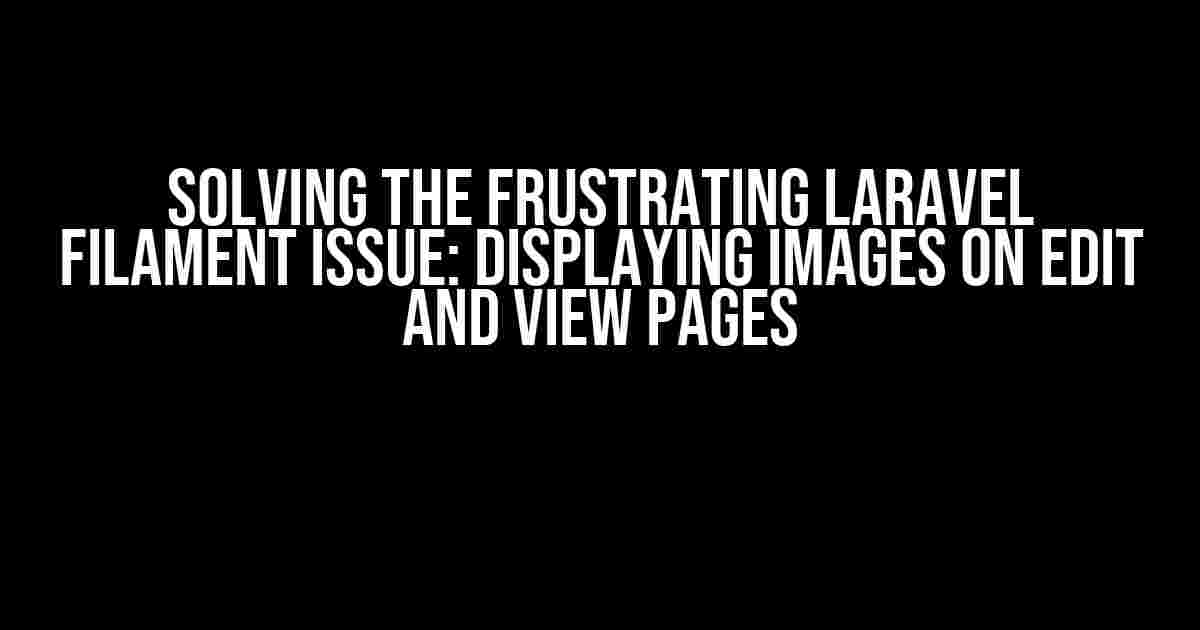Are you tired of scratching your head over the infamous Laravel Filament issue where images refuse to show up on edit and view pages? You’re not alone! Many developers have struggled with this problem, but fear not, dear reader, for we’ve got the solution right here!
Understanding the Problem
Before we dive into the fix, let’s quickly understand the issue. Laravel Filament is a fantastic tool for building admin panels, but sometimes, it can be a bit finicky when it comes to displaying images. The problem arises when you try to show an image on an edit or view page, and all you get is a broken image icon or, worse, nothing at all.
The Culprits Behind the Issue
There are a few culprits behind this issue:
public_path()vs.asset()functions- Incorrectly configured file systems
- Incorrectly stored image paths
- Filament’s default image rendering mechanism
Solving the Issue: A Step-by-Step Guide
Now that we’ve identified the culprits, let’s get down to business and fix the issue once and for all!
Step 1: Configure Your File Systems
In your Laravel project, navigate to the config/filesystems.php file and make sure you have the following configuration:
'default' => env('FILESYSTEM_DISK', 'public'),
'disks' => [
'public' => [
'driver' => 'local',
'root' => storage_path('app/public'),
'url' => env('APP_URL').'/storage',
'visibility' => 'public',
],
],
This configuration tells Laravel to use the public disk as the default file system.
Step 2: Store Image Paths Correctly
When storing image paths, make sure you’re using the correct method. Instead of storing the absolute path, store the path relative to the public disk. For example:
$imagePath = 'images/' . $image->getClientOriginalName();
Storage::putFileAs('public/' . $imagePath, $image, 'public');
This code stores the image in the public/images directory and returns the relative path.
Step 3: Use the Correct Function to Display Images
When displaying images, use the asset() function instead of public_path(). For example:
<img src="{{ asset('storage/' . $imagePath) }}" alt="Image">
This code uses the asset() function to generate the correct URL for the image.
Step 4: Override Filament’s Default Image Rendering
Filament has a default image rendering mechanism that can sometimes interfere with our custom implementation. To override this, create a new file called Image.php in the app/Models directory:
namespace App\Models;
use Illuminate\Database\Eloquent\Model;
use Illuminate\Support\Str;
class Image extends Model
{
public function url(): string
{
return asset('storage/' . $this->path);
}
}
This code creates a new Image model that overrides the default image rendering mechanism.
Step 5: Update Your Filament Resources
Finally, update your Filament resources to use the new Image model:
namespace App\Filament\Resources\ImageResource;
use App\Models\Image;
use Filament\Resources\Form;
use Filament(Resources\Pages\EditRecord;
class EditImageRecord extends EditRecord
{
protected function getForm(): Form
{
return Form::make()->schema([
// ...
Form::image('image')->label('Image')->required(),
// ...
]);
}
}
This code updates the Filament resource to use the new Image model and displays the image correctly on the edit page.
Troubleshooting Common Issues
Even with the steps above, you might still encounter some issues. Here are some common problems and their solutions:
| Issue | Solution |
|---|---|
| Image not showing on edit page | Check that the image path is correctly stored and that the asset() function is used to display the image. |
| Broken image icon on edit page | Check that the image exists in the correct location and that the file system is correctly configured. |
| Image not showing on view page | Check that the Image model is correctly configured and that the image path is correctly stored. |
Conclusion
And there you have it, folks! With these steps, you should now be able to display images correctly on edit and view pages in Laravel Filament. Remember to configure your file systems correctly, store image paths relative to the public disk, use the asset() function to display images, and override Filament’s default image rendering mechanism.
If you’re still stuck, don’t hesitate to reach out to the Laravel community or Filament’s official documentation for further assistance.
- Laravel Filesystem Documentation
- Filament Forms Documentation
- Laravel Issue #3098: public_path() vs. asset()
Happy coding, and may the images be ever in your favor!
Frequently Asked Question
Struggling with Laravel Filament’s image display on edit and view pages? Don’t worry, we’ve got you covered! Check out these FAQs to troubleshoot the most common issues.
Why are my images not displaying on the edit page?
This might be because you haven’t configured the `filament.image_manager.disk` and `filament.image_manager.path` settings in your `config/filament.php` file. Make sure to set the correct disk and path for your image uploads.
My images are displaying on the edit page, but not on the view page. What’s going on?
This could be due to the lack of `withMedia()` or `loadMedia()` method in your resource’s `form()` or `table()` method. Ensure you’re including the media in your resource’s definition to display images on the view page.
I’ve checked the above, but my images are still not showing. What’s next?
Verify that the image files are actually uploaded to the correct location and the file permissions are set correctly. Also, check if there are any JavaScript errors on the page that might be preventing the images from loading.
How do I display a default image if no image is uploaded?
You can use the `defaultUrl` attribute on the `Image` field to specify a default image URL. For example, `
